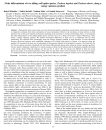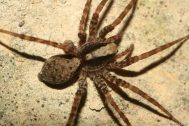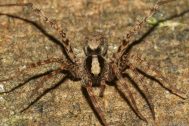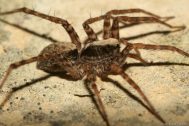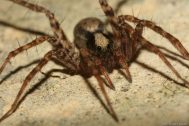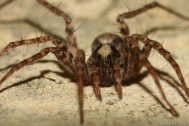| Records by time | |||||
|---|---|---|---|---|---|
| Lycosidae | 0-1900 | 1901-1950 | 1951-2000 | 2001+ | ∑ |
| Pardosa alacris (C. L. Koch, 1833) Not endangered | 238× | 275× | 513× | ||
Pardosa alacris (C. L. Koch, 1833)
| Czech name | slíďák hájový |
|---|---|
| Threat level | Not endangered |
| Records | 513 nálezů, 101 kvadrátů |
| First record |
1860, F. Prach, Prach 1860 |
| Last record | 2025 , Aleš Prágr |
| Distribution area | European - Me.? (Greece |
| Phytogeographic area |
|
| Původnost stanovišť |
|
| Humidity |
|
| Stratum |
|
| Osvětlení stanovišť |
|
| Hojnost výskytu |
|
| Altitude | 150-800 |
Bibliography
Synergistic effects of glyphosate formulation herbicide and tank-mixing adjuvants on Pardosa spiders.
Glyphosate-based herbicides are the world’s most consumed agrochemicals, and they are commonly used in various agroecosystems, including forests, as well as in urban zones and gardens. These herbicides are sold as formulations containing adjuvants. Other tank-mixing adjuvants (most often surfactants) are commonly added to these formulations prior to application. According to the manufacturers of agrochemicals, such tank mixes (as these are known in agronomic and horticultural practice) have modified properties and perform better than do the herbicides as used alone. The effects of these tank mixes on the environment and on beneficial arthropods are almost unknown. Therefore, we studied whether a herbicide formulation mixed with adjuvant has modified effects on one of the most common genera of ground-dwelling wolf spiders vis- a-vis the herbicide formulation and adjuvants themselves. Specifically, we studied the synergistic effect in the laboratory on the predatory activity (represented by the number of killed flies) of wolf spiders in the genus Pardosa after direct treatment using the glyphosate-based herbicide formulation Roundup klasik Pro ® , Roundup klasik Pro ® in a mixture with the surfactant Wetcit ® , Roundup klasik Pro ® in a mixture with the surfactant Agrovital ® , and the surfactants alone. We found that pure surfactants as well as herbicide-and-surfactants tank mixes significantly decrease the predatory activity of Pardosa spiders in the short term even as Roundup klasik Pro ® did not itself have any such effect. Our results support the hypothesis that plant protection tank mixes may have modified effect on beneficial arthropods as compared to herbicide formulations alone. Therefore, testing of pesticide tank mixes is highly important, because it is these tank mixes that are actually applied to the environment.Epigeic Spiders from Lowland Oak Woodlands in the South Moravia Region (Czech Republic).
This paper presents spider faunistics from abandoned coppice oak forest stands located along the South Moravia region. Spiders were collected from May to July 2012 by pitfall trapping at eight different localities. We collected 1945 adult spiders representing 20 families, 53 genera, and 90 species. More than one-third of all the species are known to be xerothermophilous with ecological restrictions to open and partly shaded habitats such as forest-steppe and sparse forests which belong to endangered habitats along central Europe. The most abundant species were Pardosa alacris, Pardosa lugubris and Arctosa lutetiana from the family Lycosidae. In the surveyed area, 24 species were found listed in the Red List of Threatened Species in the Czech Republic (CR – 1 species, EN – 2 species, VU – 15 species, LC – 6 species). In general, we discovered a substantially diversified spider community with a large presence of rare and endangered species characteristic for open and xeric habitats.
Gallery
Statistics
By month
By altitude
By collecting method (513 used records)
| Pardosa alacris (C. L. Koch, 1833) ES | Males | Females | Juveniles | Records |
|---|---|---|---|---|
| Zemní past | 4670 | 1364 | 78 | 255 |
| Individuální sběr | 286 | 22 | 0 | 59 |
| Prosev | 21 | 7 | 0 | 9 |
| Nárazová past | 3 | 2 | 0 | 3 |
| Smyk | 41 | 1 | 0 | 7 |
| Vysavač | 0 | 1 | 0 | 1 |
| Neurčeno | 793 | 219 | 1 | 177 |
| Sklepávání | 2 | 0 | 0 | 2 |
| Males | Females | Juveniles | Records |
By biotope (513 used records)
| Pardosa alacris (C. L. Koch, 1833) ES | Males | Females | Juveniles | Records |
|---|---|---|---|---|
| Písčiny | 1 | 0 | 0 | 2 |
| Travnaté stepi | 1 | 1 | 0 | 2 |
| Rákosiny a orobincové porosty stojatých vod | 11 | 0 | 0 | 2 |
| Stepi, vřesoviště, písčiny | 1 | 0 | 0 | 1 |
| Mokřadní olšiny | 2 | 1 | 0 | 3 |
| Lesostepní doubravy | 76 | 1 | 0 | 8 |
| Kamenolomy | 143 | 25 | 0 | 22 |
| Nehluboké podzemní prostory (pukliny, půdní horizonty) | 3 | 2 | 0 | 1 |
| Skalní stepi na jiných horninách | 24 | 2 | 0 | 1 |
| Dubohabřiny | 20 | 0 | 0 | 6 |
| Neurčeno | 4755 | 1339 | 1 | 313 |
| Lesy | 4 | 1 | 0 | 9 |
| Suché louky | 121 | 40 | 1 | 29 |
| Vlhké lesní lemy | 1 | 1 | 0 | 2 |
| Mezofilní louky | 6 | 0 | 0 | 1 |
| Suché doubravy | 175 | 75 | 76 | 22 |
| Výsadby listnáčů | 1 | 1 | 0 | 1 |
| Paseky | 20 | 1 | 0 | 3 |
| Suťové a roklinové lesy | 7 | 0 | 0 | 5 |
| Bučiny nižších poloh | 9 | 0 | 0 | 5 |
| Louky | 95 | 0 | 0 | 4 |
| Ovocné sady s luční vegetací | 6 | 0 | 0 | 2 |
| Vrbové křoviny - vlhké (vrbové) křoviny | 8 | 2 | 0 | 1 |
| Křoviny | 2 | 0 | 0 | 1 |
| Okraje silnic | 81 | 78 | 0 | 3 |
| Stinné skály nižších poloh | 14 | 6 | 0 | 9 |
| Lesní okraje | 64 | 0 | 0 | 10 |
| Reliktní bory na skalách | 63 | 18 | 0 | 8 |
| Suché křoviny | 0 | 5 | 1 | 2 |
| Kamenité suti nižších poloh | 13 | 15 | 0 | 8 |
| Lesy | 43 | 0 | 0 | 4 |
| Porosty borůvek | 13 | 0 | 0 | 5 |
| Xerotermní travinobylinná společenstva | 2 | 0 | 0 | 2 |
| Přirozené lesy | 7 | 0 | 0 | 5 |
| Skalní stepi na vápenci | 6 | 0 | 0 | 3 |
| Horské bučiny | 2 | 0 | 0 | 1 |
| Lužní lesy nížin | 2 | 0 | 0 | 2 |
| Haldy a výsypky | 3 | 1 | 0 | 1 |
| Výsadby jehličnanů | 0 | 1 | 0 | 1 |
| Lesní cesta | 1 | 0 | 0 | 1 |
| Těžebny písku a jiných nezpevněných hornin | 2 | 0 | 0 | 1 |
| Ostatní pole | 8 | 0 | 0 | 1 |
| Males | Females | Juveniles | Records |


